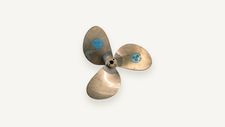
Full Steam Ahead
The idea came into being around a kitchen table in 1983: a ship was required to measure pollutants that industry was pouring into the rivers, directly at their source. A year later, Greenpeace Germany acquired an old firefighting ship and christened it MS Beluga. The snow-white ship with its unmistakeable rainbow was equipped with a modern lab and was active in North Rhine-Westphalia in the 1980s.
In 1987, the propeller you can see here spun into motion and the Beluga set course for the Bayer plant in Leverkusen. Numerous Greenpeace activists suspended themselves from a bridge, hanging side by side over the shipping channel to keep other boats away from the Beluga. Thus protected by a curtain of people, the Beluga was able to approach the sewage pipes. With the help of a professional diver, samples were successfully obtained. The action attracted attention and brought the problem of water pollution into the public eye.
This was not the only spectacular environmental protest on the Rhine. It, like many other bodies of water in North Rhine-Westphalia, has been in a poor state for years. Rivers have to take in the wastewater of communities and industries while simultaneously providing drinking water for millions of people.
Municipalities, water management associations and industries reacted by building water treatment plants. Water providers developed new processing technologies. And a laboratory ship, the Max Prüss, has been in use since the 1960s. But it took the protests of citizens’ initiatives and environmental organisations to force companies to recognise their responsibilities.